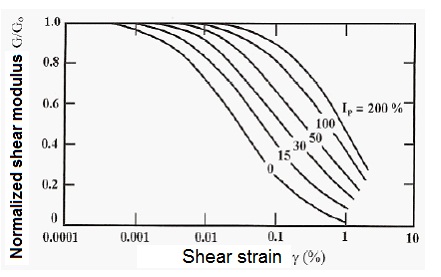Calculation of the shear modulus G
The shear modulus to be introduced in the above equations can be calculated by referring to diagrams of the type of those shown in the figure below, in which the trend of the shear modulus is a function of shear strain and of plasticity index of the soil PI.

Diagram used for the calculation of the shear modulus
As can be observed to be plotted is not directly G but rather the ratio G/G0 where G0 is the dynamic low strain shear modulus. The modulus G0 can be derived by correlating it with the S-waves velocity of the layer:
![]()
Where r is the mass density of the soil created by the unit weight divided by the gravitational acceleration in m/s2 (9.81 m/s2). Alternatively, there are several formulations for the evaluation of G0, including the following:
Method of Imai and Tomauchi
This method correlates the dynamic low strain shear modulus with the average peak strength:
![]()
Where qc is the average peak strength in the layer measured with the static penetrometer. The result is expressed in kg/cm2.
Method of Ohsaki & Iwasaki
This method becomes valid as part of clean sand or plastic sand. This method correlates the low strain shear modulus with the number of blows in the layer and with the average particle size (granulometry) of the ground:
![]()
Where Nspt is the average number of blows of the layer and the constants a and b are shown in table below:
a |
b |
Granulometry |
|---|---|---|
650 |
0.94 |
Clean sand |
1182 |
0.76 |
Plastic sands |
Values of parameters used in the formula of Ohsaki & Iwasaki
© GeoStru